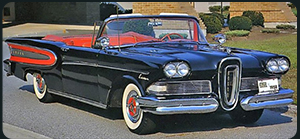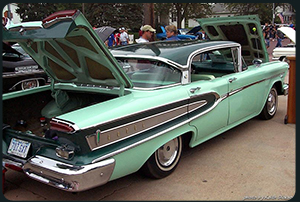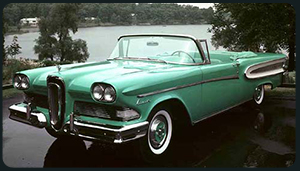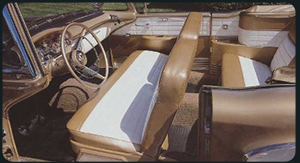1958-60 Edsel
The next time you think about making fun of Ford Motor's 1958-60 Edsel, consider that an Edsel coupe in top condition is valued at $16,400 and that a convertible is worth a cool $47,000.
The Edsel was an abject marketing failure, but the car probably would have been a hit if introduced in car-crazy, prosperous 1955--a tremendous sales year for major American automakers.
Instead, the Edsel arrived during a bad recession late in 1957 for the 1958 model year, which was disastrous for most car producers. One historian said that the Edsel's "aim was right, but the target moved" Making matters worse, the car was given far too much promotion by Ford, raising buyer and media expectations way too high.
The media initially was enthusiastic, but turned against the Edsel when they saw the public didn't love it.
Moreover, the public was becoming interested in much smaller, more economical cars, such as the Nash Rambler, Studebaker Lark and Volkswagen Beetle. And there were too many autos in the fairly large Edsel's size and medium-price class.
Even Ford Motor's established Mercury could be bought for about the price of an Edsel, which was designed to bridge the gap between Ford and Mercury models. Indeed, the Edsel was a Mercury or Ford (depending on the model) under
the skin. It had a substantial steel girder chassis and could be had with powerful V-8s of up to 345 horsepower--and every power accessory known to man. It was a solid performer.
And those who think the Edsel's flamboyant styling was too offbeat, they should consider the gaudy, hugely overchromed 1958 models from General Motors. The car's grille was criticized, but most weren't aware that the famous 1930s Bugatti sports car also had a "horseshoe grille." And the limited-production Gaylord sports car and Packard Predictor auto show cars of the 1950s had variations of the vertical grille concept used for the Edsel.
The Edsel was criticized for having gadgets, but it only had a few unusual items such as automatic transmission pushbuttons in the steering wheel hub and a rotating drum speedometer that changed color as speed rose. Workmanship left something to be desired, but that was typical of the times.




The Edsel resulted from marketing studies done by Ford in the early 1950s. It was meant to compete as two complete car lines--one priced under Mercury with Ford components and one priced between Mercury and Ford's top-line Lincoln that mostly shared parts with Mercury.
The Edsel would have its own dealers and compete directly against medium-priced General Motors and Chrysler autos. It did fairly well in its first model year, although it arrived as the first of the 1958 models with 1958 prices when most dealers were selling cut-rate 1957 models to get rid of inventories.
Despite everything, sales of 63,110 Edsels let the car outdo a few established rivals, which wasn't bad for a new auto line in a recession year. But Ford had hoped for sales of at least 100,000 units--and Robert McNamara disliked the Edsel because it used profits from the Ford division he headed before entering government service.
The bewildering array of Edsel models didn't help matters. The car's two basic chassis/drivelines were for four separate series--Ranger, Pacer, Corsair and Citation--spread over 18 different models.
There were two- and four-door hardtops, two- and four-door sedans, convertibles and six- or nine-passenger station wagons with two or four doors.
Many car buyers were confused just trying to figure out differences between the top-line, lavishly
equipped, 345-horsepower Citation models and base, shorter-wheelbase, 303-horsepower Ranger models.
Even the Edsel's name seemed all wrong. Ford Chairman Ernest Breech ignored a list of thousands of names from Ford's advertising agency and decided to call the new car the Edsel--after Henry Ford I's only son, Edsel Ford I, an imaginative Ford president who had died in the early 1940s after coming up with stylish cars such as the original Lincoln Continental.
But "Edsel" was a flat, meaningless name to most Americans.
Ford hurried to make the 1959 Edsel more buyer-friendly and to give it a more distinct market niche. It now was based only on the Ford chassis and body shell.
Styling, especially the front-end look, was more conservative. Pacer and Citation models were dropped, and only one wheelbase was offered. Plenty of models still were offered, but base prices were kept in a narrow range below Mercury prices. Even a six-cylinder engine was available to attract the growing number of fuel-conscious car buyers.
But it was too late. People who bypassed the Edsel in 1958 weren't about to buy it in 1959, when only 44,891 Edsels were built as people turned to more-established auto makes.
Only 2,846 Edsels--including just 76 convertibles--were built in 1960 before production ended. The last model was only a mildly restyled Ford--with a conventional grille.
It's taken decades for the Edsel to get the respect it deserves. Even an Edsel station wagon is valued at $12,900.






